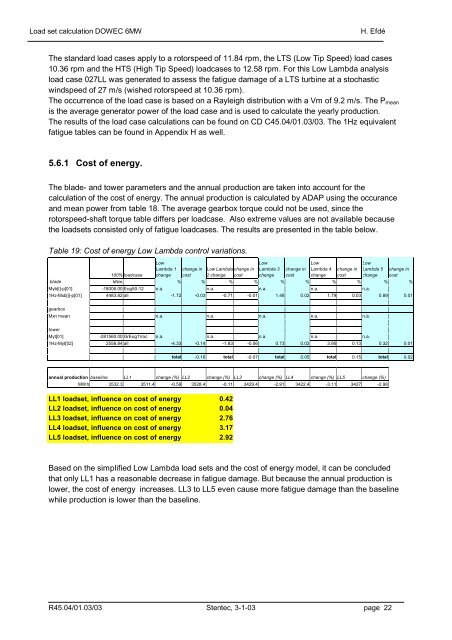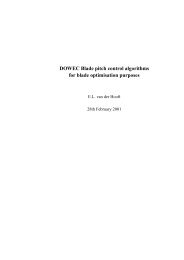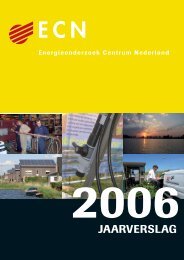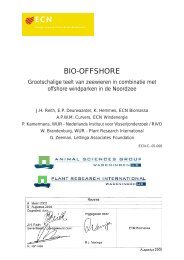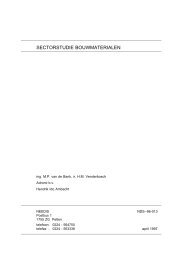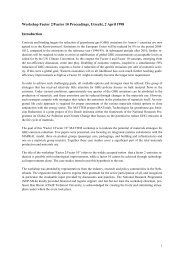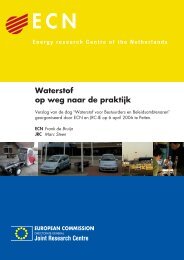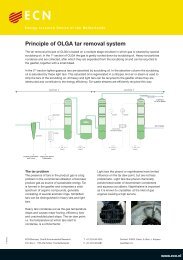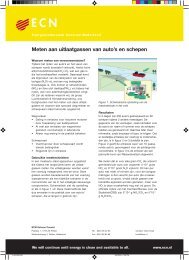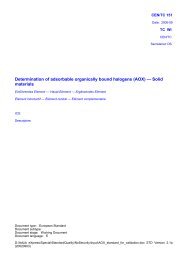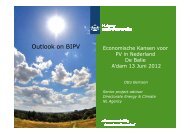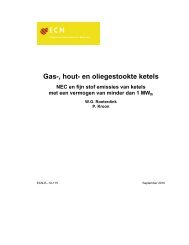10089_001.pdf - Load set calculation - ECN
10089_001.pdf - Load set calculation - ECN
10089_001.pdf - Load set calculation - ECN
Create successful ePaper yourself
Turn your PDF publications into a flip-book with our unique Google optimized e-Paper software.
<strong>Load</strong> <strong>set</strong> <strong>calculation</strong> DOWEC 6MW H. Efdé<br />
The standard load cases apply to a rotorspeed of 11.84 rpm, the LTS (Low Tip Speed) load cases<br />
10.36 rpm and the HTS (High Tip Speed) loadcases to 12.58 rpm. For this Low Lambda analysis<br />
load case 027LL was generated to assess the fatigue damage of a LTS turbine at a stochastic<br />
windspeed of 27 m/s (wished rotorspeed at 10.36 rpm).<br />
The occurrence of the load case is based on a Rayleigh distribution with a Vm of 9.2 m/s. The Pmean<br />
is the average generator power of the load case and is used to calculate the yearly production.<br />
The results of the load case <strong>calculation</strong>s can be found on CD C45.04/01.03/03. The 1Hz equivalent<br />
fatigue tables can be found in Appendix H as well.<br />
5.6.1 Cost of energy.<br />
The blade- and tower parameters and the annual production are taken into account for the<br />
<strong>calculation</strong> of the cost of energy. The annual production is calculated by ADAP using the occurance<br />
and mean power from table 18. The average gearbox torque could not be used, since the<br />
rotorspeed-shaft torque table differs per loadcase. Also extreme values are not available because<br />
the load<strong>set</strong>s consisted only of fatigue loadcases. The results are presented in the table below.<br />
Table 19: Cost of energy Low Lambda control variations.<br />
Low<br />
Low<br />
Low<br />
Low<br />
Lambda 1 change in Low Lambda change in Lambda 3 change in Lambda 4 change in Lambda 5 change in<br />
100% loadcase change cost 2 change cost change cost change cost change cost<br />
blade kNm % % % % % % % % % %<br />
Myb[i]-p[01] -18006.00 Eog50-12 n.a. n.a. n.a. n.a. n.a.<br />
1Hz-Mxb[i]-p[01] 4483.82 all -1.72 -0.03 -0.71 -0.01 1.46 0.02 1.79 0.03 0.89 0.01<br />
gearbox<br />
Mxn mean n.a. n.a. n.a. n.a. n.a.<br />
tower<br />
Myt[01] -281560.00 GrEog1Voc n.a. n.a. n.a. n.a. n.a.<br />
1Hz-Myt[02] 2558.84 all -4.33 -0.14 -1.83 -0.06 0.73 0.02 3.95 0.13 0.32 0.01<br />
total -0.16 total -0.07 total 0.05 total 0.15 total 0.02<br />
annual production baseline LL1 change (%) LL2 change (%) LL3 change (%) LL4 change (%) LL5 change (%)<br />
MWh 3532.3 3511.4 -0.59 3528.4 -0.11 3429.4 -2.91 3422.4 -3.11 3427 -2.98<br />
LL1 load<strong>set</strong>, influence on cost of energy 0.42<br />
LL2 load<strong>set</strong>, influence on cost of energy 0.04<br />
LL3 load<strong>set</strong>, influence on cost of energy 2.76<br />
LL4 load<strong>set</strong>, influence on cost of energy 3.17<br />
LL5 load<strong>set</strong>, influence on cost of energy 2.92<br />
Based on the simplified Low Lambda load <strong>set</strong>s and the cost of energy model, it can be concluded<br />
that only LL1 has a reasonable decrease in fatigue damage. But because the annual production is<br />
lower, the cost of energy increases. LL3 to LL5 even cause more fatigue damage than the baseline<br />
while production is lower than the baseline.<br />
R45.04/01.03/03 Stentec, 3-1-03 page 22


